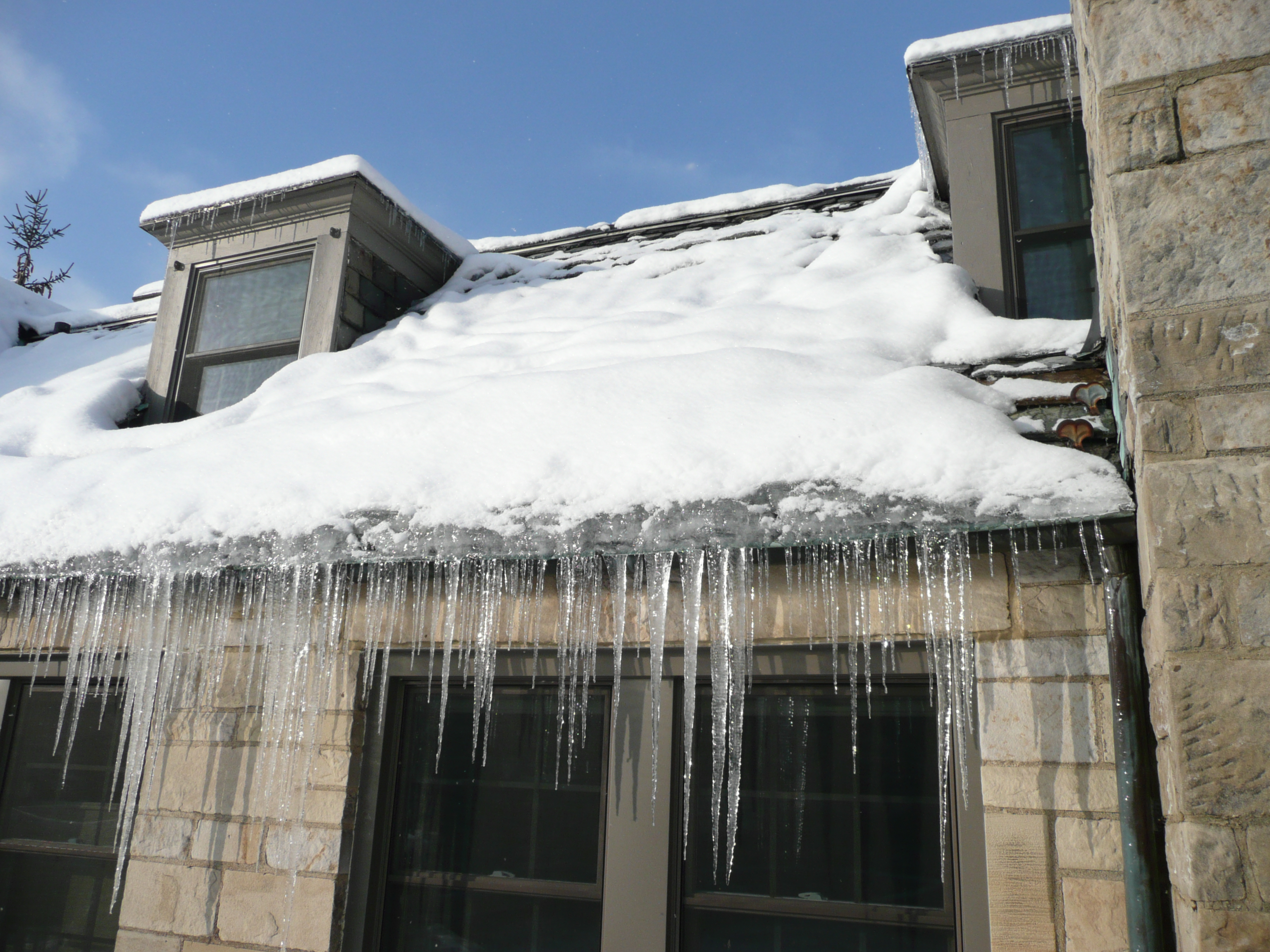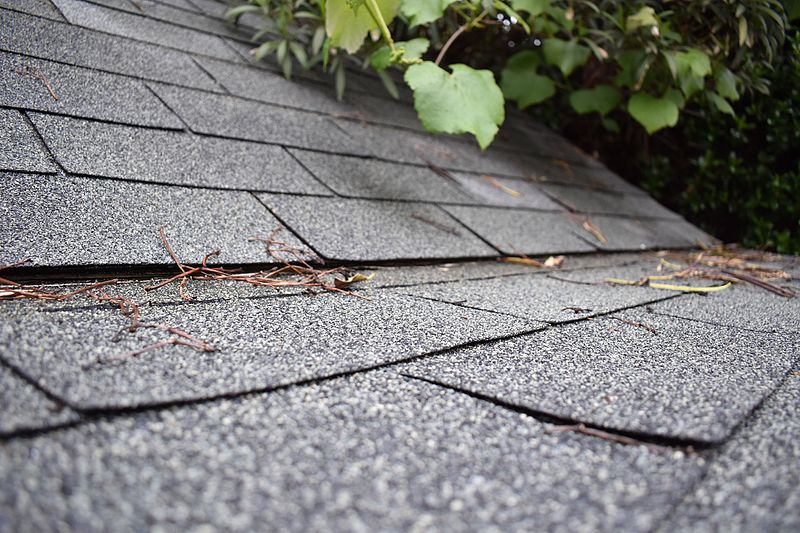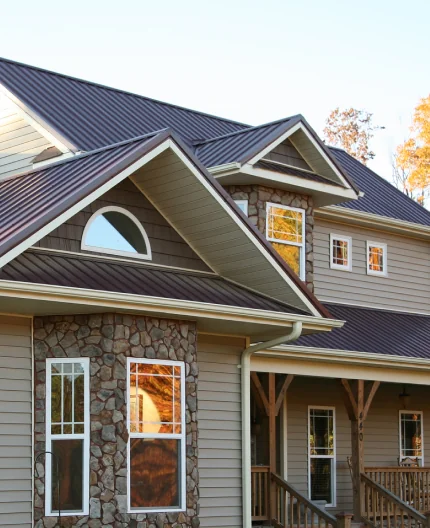How to Prevent Seasonal Roof Damage
Published on Tuesday August 9, 2016Winter, spring, summer, and fall each bring their unique challenges to your home and your roof. Let’s learn how the whole roof system protects your home and your family from seasonal roof damage.
Winter roof damage: Beware of the icicle

Problem: The greatest threat your roof faces during the winter is ice damming. Ice damming occurs when the sun and heat from inside your home conspire to melt the snow and ice on your roof.
The meltwater flows to the edges of your roof, where it refreezes and creates a literal dam that prevents more meltwater from running off. Icicles – sometimes really big ones – begin to form.
These ice dams are not good: not only can they cause roof damage, but can also harm your attic and the interior walls of your home. How can you prevent ice damming?
Solutions: Effective ventilation, fiberglass roof underlayment.
A properly vented roof is your best defense against ice damming. Exhaust vents, like ridge vents, allow warm, moist air to escape your attic while intake vents enable cool air to enter. A cooler attic means less snow and ice melt, which helps prevent damming.
A quality fiberglass underlayment like Winterguard® from CertainTeed provides an added waterproof barrier that keeps thawing ice from damaging the roof deck underneath.
Winterguard is a sticky and elastic asphalt polymer that seals around the nails driven through it. It should be applied at vulnerable areas like the edges of your roof or at seams where water from melting ice is most likely to penetrate.
Summer roof damage: Shingles save the day

Problem: Like you, your roof isn’t immune to the harmful effects of the sun’s heat and UV rays. As the sun beats down on your roof, that heat transfers to the inside of the attic.
According to the Asphalt Roofing Manufacturer’s Association (ARMA), the temperature inside your attic can be nearly 65% hotter than the temperature outdoors. This heat buildup in your attic can cause serious roof damage, forcing your shingles to deteriorate rapidly from the inside out.
Exposure to UV rays can also degrade the asphalt in your shingles, making them brittle. Brittle shingles can crack, and cracks are a direct route for water to infiltrate your roof.
Solutions: Effective ventilation, quality asphalt shingles.
The same exhaust and intake vents that benefit your roof in the winter save your roof in the summer, too. Excess heat buildup escapes through the ridge vents. Cooler air enters through the edge vents. Attic temperatures go down. That’s science in action!
Excess moisture that rises with the heat is also expelled. If not vented, this moisture can cause severe roof damage, allowing mold to grow or rotting your roof from the inside out.
Quality asphalt shingles are made to withstand the sun’s damaging UV rays. Shingles are made up of several functional layers: backsurfacing, asphalt, fiberglass basemat, and granules.
The opaque, UV-resistant granules that also give shingles their colors are the primary defense against UV damage. Made of mineral, brick, or ceramic, the opaque granules keep the sun’s rays from reaching the asphalt underneath.
Roof damage in the spring and fall: Weathering the storms

Problem: We’ve all experienced those scary spring storms that shock you awake in the middle of the night: howling wind, sheets of rain, rolling thunder. You dread fallen trees, downed wires, or disastrous roof damage. It’s scary.
In the fall, storms may not be quite as severe, but there is still a considerable amount of rain, debris, and wind as the temperature changes and leaves fall from the trees.
Feel confident that your roof can stand up to these challenges?
Solutions: Asphalt starter shingles, drip edge, flashing, fiberglass underlayment, gutters.
Quality roofing materials like asphalt shingles, flashing, fiberglass underlayment, and drip edge all prevent roof damage by working to keep the water off of your roof and out of your home.
- Asphalt starter shingles are specially designed to resist tear-off from the wind. A superior sealant on the underside of starter shingles keeps them in place at the edges of your roof, where shingle application starts and wind forces are strongest.
- Drip edge is a thin, narrow, non-porous strip of sheet metal that bends over the outside edges of your roof. It essentially wraps the edge of the roof decking in a protective layer. Drip edge should be installed OVER the underlayment at the rakes to prevent wind and rain from getting under the rough edge of the shingle. The drip edge is installed UNDER the underlayment at the eaves where it is an added layer of defense against sitting water from ice dams or clogged gutters.
- Flashing keeps the water flowing at the places where the roof meets a wall, like the base of a chimney, a porch, or a dormer. These eaves and valleys are the places where your roof is most vulnerable to water penetration.
- Underlayment is the last line of water defense. Like winter, this waterproof or water-resistant layer applied under your shingles keeps your roof decking dry.
- High-quality asphalt shingles stand up to all of the challenges that spring and autumn bring—it’s their job! The asphalt in good shingles makes them tough enough to handle wind and small debris, and that’s why we use CertainTeed shingles. “CertainTeed is UL Certified to meet the industry standard for measured toughness of a shingle, ASTM D3462,” Jeff Frantz, Washington, D.C. metro area Territory Manager for CertainTeed Roofing Products says. “This test is for tear resistance, nail pull resistance, and pliability. Certified to meet UL is a key quality standard at CertainTeed.”
- While gutters aren’t technically part of the roof itself, gutters play an important role in your whole roof system. Clogged gutters from falling leaves can allow moisture to stay at the eaves. This moisture can contribute to the formation of ice dams that cause roof damage in the winter months. Autumn is a great time to have your gutters cleaned or have a gutter guard installed to keep them clean and clear. You can call a local company like Long Roofing to have your roof and gutters checked for damage so repairs can be made before the harsh winter weather sets in.
Will your roof last another season? Talk to us.
A well-constructed roof made of quality roofing materials is guaranteed by warranty to withstand 50 years of cold and snow, heat and sun, wind and rain — that is, when you get a roof replacement from Long Roofing. If you’re worried that your roof is on its last legs, contact us to set up a free estimate today.
When you need a new roof, contact Long Home Products or online to get a price, schedule a free, in-home consultation or find answers to any home roofing questions.
Interested in Long Home Products?
See our special offers now.
*Excludes labor. Subject to credit approval.
**Excludes labor. Subject to credit approval.
One-day installs contingent upon municipal rules and regulations.
By submitting a form, I authorize Long Home Products to contact me with information abouts its products and services via mail, email, phone and/or text at the contact information provided, even if I am on the national do not call list. Long Home Products may use automated telephone technology to initiate calls to its customers. Calls and in person estimates may be recorded for quality and training purposes.








